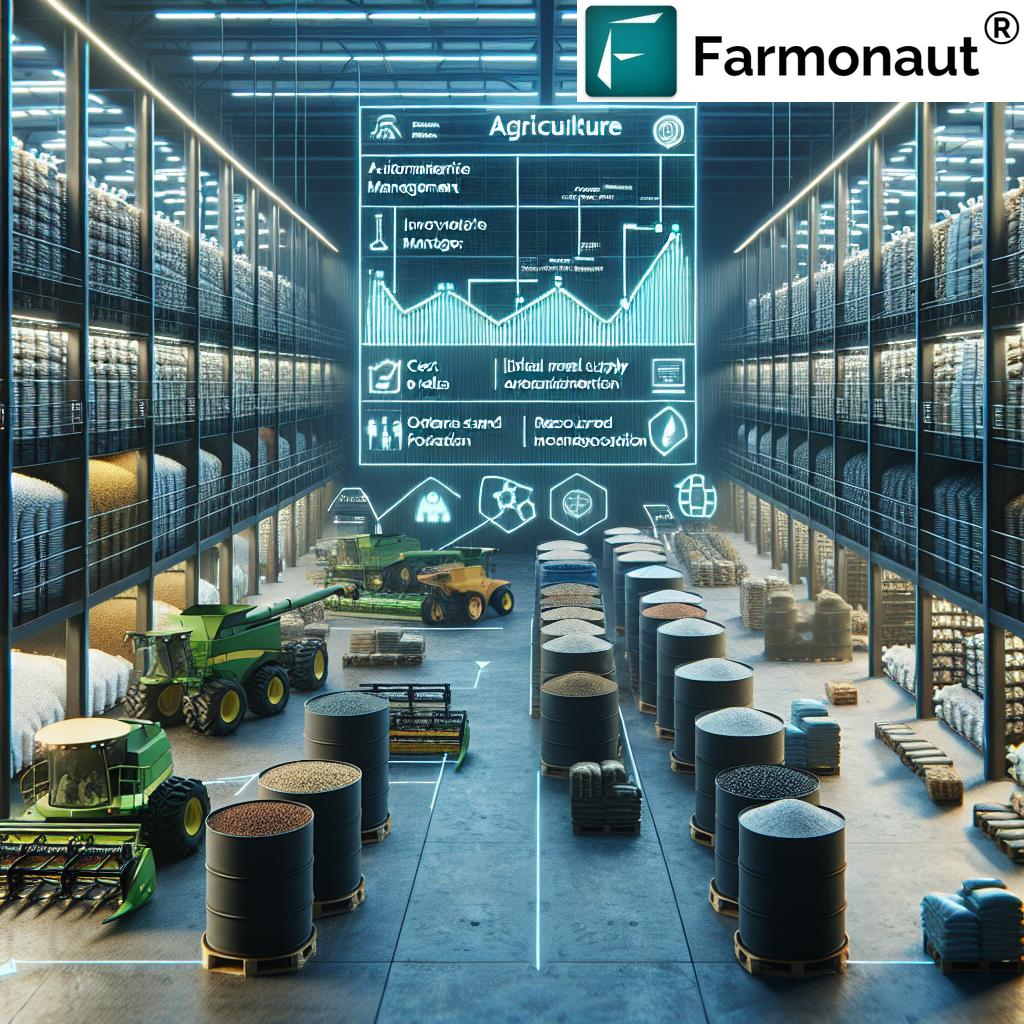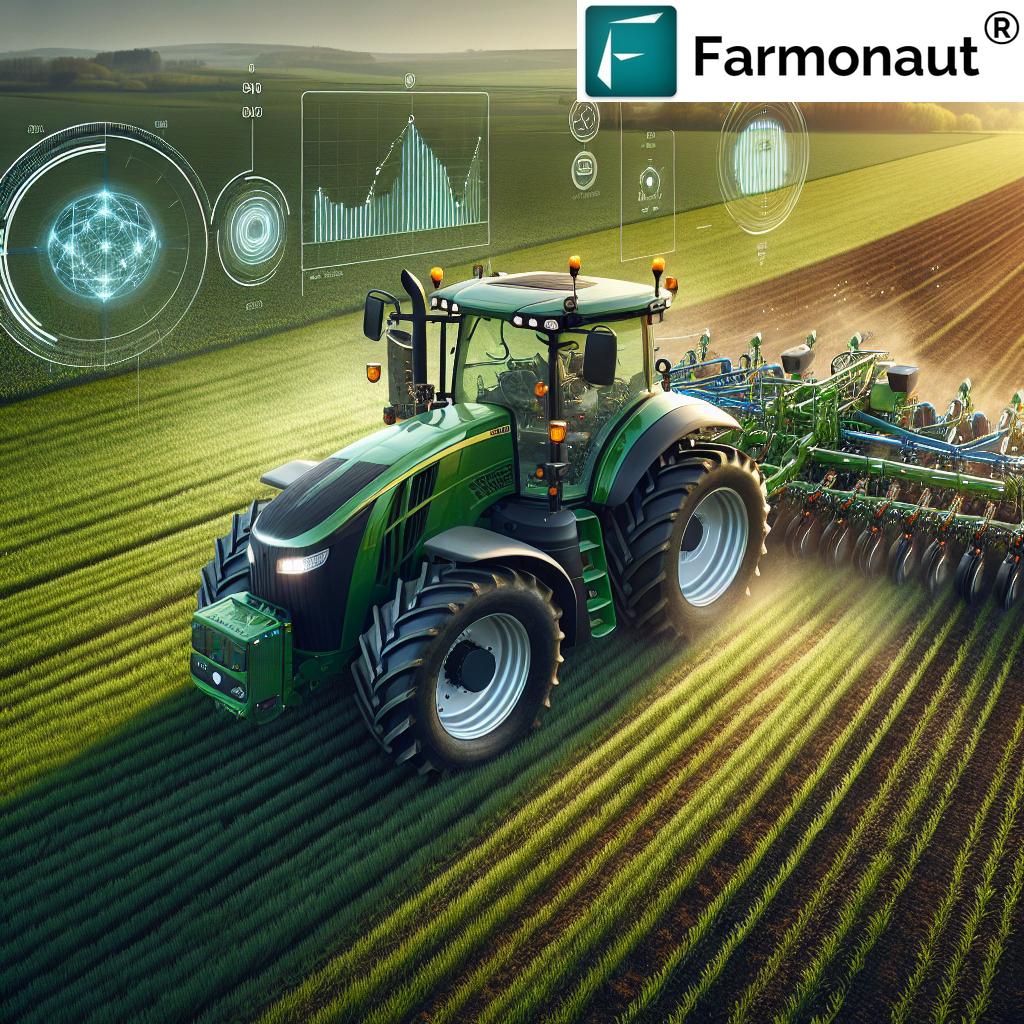Streamline Farm Operations: 7 Ways to Boost Efficiency
Summary: Streamlining farm operations is essential for improving productivity, reducing costs, and ensuring sustainability. By integrating precision agriculture technology, optimizing resource management, leveraging farm management software (FMS), and adopting data-driven practices, farmers can revolutionize their operational efficiency. This blog explores seven impactful methods, supported by modern tools and strategies, to enhance every aspect of farm management, from crop monitoring and analytics to sustainable practices.
Table of Contents
- Embracing Technology and Automation
- Efficient Inventory and Resource Management
- Data-Driven Decision Making in Agriculture
- Labor Management and Scheduling
- Financial Management
- Compliance and Reporting
- Supply Chain Optimization
- Sustainable Farming Practices
- Continuous Improvement and Adaptation
- Comparative Impact Table: Streamlining Farm Operations Technologies
- Farmonaut Subscription Plans
- FAQs: Streamlining Farm Operations
- Conclusion
“Precision agriculture can increase crop yields by up to 20% through targeted resource application and data-driven decisions.”
1. Embracing Technology and Automation: Precision Agriculture and FMS
One of the main drivers behind the transformation of modern agriculture is the integration of advanced technology and automation. This shift helps streamline farm operations, making every stage of crop production, resource management, and data collection more efficient and cost-effective.
Precision Agriculture Technology: Optimizing Resource Management
Precision agriculture employs innovative tools like GPS-guided tractors, soil sensors, and drone imaging to provide actionable insights into field conditions, crop health, and resource requirements. By utilizing this real-time data, farmers can adopt targeted application of fertilizers and pesticides, thus minimizing waste and maximizing efficiency.
- Benefits: Improved resource allocation, enhanced crop yields, and reduced input costs (Source).
- Automated monitoring: Drones equipped with multi-spectral cameras perform crop monitoring and analytics, detecting issues like disease, pest infestation, and nutrient deficiency at an early stage for timely interventions.
- Satellite imagery: Satellite-based solutions such as those from Farmonaut empower farmers to monitor field variability, irrigation needs, and progress with ease.
Farm Management Software (FMS): Centralizing Task and Data Management
Farm management software (FMS) is a cornerstone for streamlining farm operations. By centralizing the collection of farm data, task management, and financial tracking, FMS gives farmers a centralized dashboard to create and assign tasks, set deadlines, and monitor progress.
- Automates routine record-keeping and reporting.
- Enables quick analysis for budget planning, expense tracking, and profitability assessments.
- Boosts operational efficiency by reducing manual administrative workload.
Learn more on optimizing tasks and data with FMS
Automated Farm Machinery: Harvesters, Smart Irrigation, and Drones
Adopting automated farm machinery —like robotic harvesters, soil-moisture-based irrigation systems, and scanning drones—dramatically increases productivity by reducing manual labor requirements and accelerating repetitive farming activities.
- Automated harvesters cover vast areas with minimal supervision, cutting labor costs and harvesting time.
- Drones: Used for crop health monitoring, application of inputs, and surveillance.
- Smart irrigation: Ensures optimal water use, reducing wastage and associated costs.
Explore advancements in automated machinery
For multi-field operations, Farmonaut’s Large-Scale Farm Management solution offers scalable, AI-backed tools to centrally monitor crop health, track machinery, and optimize resource deployment.
“Farm management software reduces administrative time by 30%, allowing farmers to focus more on core operations.”
2. Efficient Inventory and Resource Management: Minimizing Waste and Reducing Costs
Effective inventory and resource management is vital for reducing costs and ensuring that essential inputs—like seeds, fertilizers, water, and equipment—are always available and used optimally.
Inventory and Input Tracking via FMS
Modern FMS centralizes inventory tracking, delivering real-time alerts when stock levels drop below threshold. Automation in this domain prevents overstocking (which ties up capital and space) or stockouts (which disrupt operations).
- Automated alerts for low inventory to avoid delays and higher emergency purchase costs.
- Supply usage tracking to identify areas of potential waste.
- Historical usage patterns help in forecasting future demand, optimizing purchase timing.
More on digital inventory management in agriculture
Resource Optimization: Patterns, Analytics, and Scheduling
By analyzing usage patterns of vital resources like water, fertilizers, and energy, farmers can fine-tune their practices, scheduling irrigations based on soil moisture and weather forecasts to mitigate excess use while maintaining crop health.
- Tracking field inputs ensures precise allocation and avoids unnecessary waste.
- Timely replenishment prevents both shortages—which affect productivity—and surplus, which inflates overhead.
Farmonaut’s Admin App enables large farms to view, track, and monitor the flow and usage of resources using integrated satellite and AI-powered tools.
Integrations like Farmonaut Fleet Management add the ability to monitor vehicle routes, fuel consumption, equipment status, and optimize logistics, cutting operational costs substantially.
3. Data-Driven Decision Making in Agriculture: Improving Farm Productivity
The use of data-driven decision making in agriculture is transforming how farmers plan, monitor, and improve all farming activities.
Real-Time Data Collection and Crop Monitoring and Analytics
FMS platforms and remote sensing tech automatically gather data from various sources: field sensors, satellite imagery, drones, and manual inputs. This centralized collection reduces human error, ensures more accurate records, and forms the basis for vital crop monitoring and analytics.
- Automated crop health monitoring
Services like Farmonaut’s Crop Health Monitoring use satellite data to track vegetation indices (NDVI), soil moisture, and field variation, empowering farmers to make informed interventions quickly and efficiently. - Weather data integration for optimal field operations.
- Resource deployment analytics assist in optimizing workforce, irrigation, pesticide and fertilizer use.
Explore the power of data-driven farm management
Predictive Analytics and Decision Support
Advanced analytics help identify trends and predict outcomes like yield, disease risk, and optimal harvest times. AI-based platforms (like Farmonaut’s Jeevn AI Advisory within its apps) deliver expert recommendations tailored to each farm’s unique conditions.
- Increase profitability through better crop timing, resource allocation, and reduction in unplanned downtime.
- Early warning systems improve resilience against weather and pest-related risks.
For seamless integrations and automation, Farmonaut’s API and Developer Docs empower external developers, cooperatives, and agriculture researchers to access robust satellite and weather data.
4. Labor Management and Scheduling: Enhancing Efficiency in Farm Operations
Efficient labor management is one of the most essential aspects of enhancing productivity while reducing costs in agriculture. Proper scheduling and training ensure all critical tasks are completed efficiently and safely.
Workforce Planning & Task Scheduling in FMS
By utilizing labor forecasting and flexible scheduling, farmers can allocate workers and resources based on real-time field demands and seasonal cycles.
- Automated job assignments help avoid bottlenecks during peak seasons.
- Efficient task tracking and progress monitoring via FMS dashboards (like Farmonaut’s centralized dashboards).
- Reduced overtime and better labor cost control.
Discover techniques for labor optimization in farming
Training and Upskilling
Continued investment in training and upskilling ensures workers are proficient in using new technology and adhering to safe, efficient practices.
- Reduces risk of accidents and mistakes.
- Improves adoption rate of innovative technology.
- Creates a culture of continuous improvement.
More on worker training for efficiency
5. Financial Management: Budgeting, Expense Control, and Profitability
Strong financial management forms the backbone of sustainable and profitable farm operations.
Budgeting and Expense Tracking in FMS
FMS platforms provide automated tools for budgeting, expense tracking, and income analysis. These features enable farmers to make strategic financial decisions, ensuring their farms remain resilient and prosperous.
- Track expenses by activity, season, or input.
- Automated financial reporting for compliance and transparency.
- Identify areas of overspending for corrective action.
More on expense tracking with FMS
Cost Analysis & Access to Financing
- Detailed breakdown of labor, input, and equipment costs reveals inefficiencies and cost-saving opportunities.
- Farmonaut’s crop loan & insurance page explains how satellite-based data enhances transparency for financial institutions and facilitates reliable loan and insurance approvals for farmers.
6. Compliance and Reporting: Ensuring Transparency and Regulatory Adherence
Adhering to agricultural regulations and maintaining accurate records is vital for operational transparency, regulatory compliance, and smooth business operation.
Automated Compliance Features in Farm Management Software
- Farm management software automates record-keeping and reporting, ensuring farmers meet evolving regulatory demands.
- Integrates with export, safety, and food quality standards.
- Auditing features streamline external and internal reviews.
Reliable Record Keeping and Blockchain-Based Traceability
- Maintaining detailed records (inputs, outputs, tasks, activities) improves transparency and strengthens trust with buyers and auditors.
- Modern solutions, like Farmonaut’s blockchain-based product traceability, ensure tamperproof documentation across the supply chain, from field to consumer.
7. Supply Chain Optimization: From Inventory to Delivery
Optimizing the supply chain ensures products are harvested, packed, and delivered efficiently—minimizing waste, meeting market demands, and improving customer satisfaction.
Inventory Management and Order Fulfillment
- Real-time tracking of commodities and finished products ensures optimal stock management, timely replenishment, and minimal waste.
- Automated order processing and fulfillment reduce errors and accelerate delivery schedules.
- Digital sales platforms help maintain accurate transaction records for better planning.
More on supply chain digitization
Blockchain for Supply Chain Transparency
Solutions like Farmonaut’s traceability application allow producers to demonstrate transparency—tracking the journey of each lot from soil to store shelf via secure, unchangeable digital ledgers.
8. Sustainable Farming Practices & Environmental Stewardship
Adopting sustainable farming practices is not only environmentally responsible but also crucial for long-term profitability and market opportunities.
- Crop rotation and cover cropping restore soil health and break disease cycles, reducing the need for chemical inputs and cutting costs (Source).
- Organic methods open up niche market channels and often command premium prices.
- Carbon footprint tracking, as enabled by tools like Farmonaut’s Carbon Footprint Tracking, quantifies and helps reduce emissions for better compliance and market appeal.
- Minimizing chemical runoff and efficient water use bolster both sustainability and regulatory reporting.
9. Continuous Improvement and Adaptation: Staying Ahead in Modern Farming
Agriculture is constantly evolving. Committing to continuous improvement and adaptation ensures long-term competitiveness and growth.
- Feedback systems (from workers and customers) identify gaps in processes and drive innovation.
- Market monitoring via FMS dashboards to quickly adapt to market trends and shifts in customer preferences.
- Flexible process updates allow for the integration of new tools and optimized practices.
Advanced platforms, like those from Farmonaut, offer AI-based advisory, real-time data analytics, and cross-platform support (Android, iOS, Web, API), keeping farmers at the forefront of modern agriculture.
Comparative Impact Table: Streamlining Farm Operations Technologies
When choosing the right combination of modern technologies to streamline farm operations, it’s essential to compare their efficiency impact, cost-saving potential, and suitability for different farm sizes. The table below summarizes key solutions:
| Technology/Practice | Efficiency Boost (Estimated %) | Cost Reduction (Estimated %) | Implementation Difficulty | Suitable Farm Size |
|---|---|---|---|---|
| Precision Agriculture Tools (GPS, Sensors, Drones) | 15-25% | 10-20% | Medium | Small / Medium / Large |
| Farm Management Software (FMS) | 12-18% | 7-15% | Low | Small / Medium / Large |
| Remote Sensing (Satellite Imagery) | 12-20% | 6-13% | Low | Medium / Large |
| Automated Farm Machinery (Harvesters, Planters) | 18-28% | 8-21% | High | Medium / Large |
| Smart Irrigation Systems | 10-17% | 9-18% | Medium | Small / Medium / Large |
| Blockchain Product Traceability | 8-13% | 4-10% | Medium | Medium / Large |
| Sustainable Farming Practices (Crop Rotation, Cover Cropping, Organic) | 10-14% | 6-12% | Low | Small / Medium / Large |
Note: Percentages are industry estimates. Suitability can vary by local context and available capital. Combining multiple methods (e.g., FMS + satellite monitoring) compounds benefits for farmers seeking to maximize productivity and sustainability.
Farmonaut Subscription Plans
If you want to leverage cutting-edge precision agriculture technology and streamline every aspect of your farm, check our flexible subscription options:
Farmonaut’s solutions—available on web, Android, iOS, and via API—make precision agriculture accessible, affordable, and actionable to farmers worldwide.
FAQs: Streamlining Farm Operations
What is the most important technology for streamlining farm operations?
Farm management software (FMS) is essential for centralizing data, automating task management, and streamlining resource optimization. When combined with precision agriculture technology like satellite imagery and drone monitoring, farmers gain powerful, actionable insights.
How do precision agriculture tools improve efficiency?
By providing real-time data on soil conditions, crop health, and input requirements, precision ag tools enable targeted applications of water, fertilizers, and pesticides—reducing waste, improving yields, and cutting costs.
What is the role of crop monitoring and analytics in improving farm productivity?
Crop monitoring and analytics deliver timely alerts about plant stress, disease, pests, and soil variability, allowing farmers to intervene quickly and precisely—maximizing output with optimal resource use.
How can small farms benefit from streamlining farm operations?
Even on a small scale, digital inventory tracking, mobile-friendly FMS, and sustainable farming practices significantly cut administrative time and improve resource allocation, resulting in higher profitability and less waste.
How does Farmonaut help farmers improve operational efficiency?
We offer scalable, satellite-powered solutions for crop health monitoring, resource management, fleet tracking, and AI-powered crop advisory. Our mission is to make precision agriculture affordable and accessible, empowering farmers to boost efficiency, reduce costs, and achieve sustainability.
What are the first steps to adopting efficient farm management practices?
Start by implementing farm management software that fits your operation size and crop type. Digitize your task tracking, inventory, and simple reporting, then gradually add sensor or satellite data for more advanced monitoring and analytics.
Conclusion: The Future of Streamlined Farm Operations
As agriculture faces challenges of climate, market dynamics, and sustainability, integrating modern technologies is no longer optional—it’s essential. Streamlining farm operations via precision tools, data-driven decision making, automated machinery, and sustainable farming practices unlocks the path to higher productivity, lower costs, and a greener future.
We at Farmonaut are dedicated to making these innovations accessible to all farmers —no matter the size, location, or type of crop. With affordable, satellite-powered real-time insights, blockchain-enabled traceability, and integrated fleet/resource management, we help our users build a future-ready, efficient, and profitable farm enterprise.
Ready to streamline your operations? Leverage Farmonaut’s advanced platform for real-time, data-driven decisions and a more profitable future in farming.














